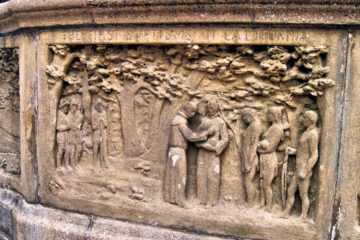
Did you know California’s first state beaches were right here in Orange County? The Orange County Historical Society will explore the history of our southern State beaches at our season kick-off program, Sept. 13, 2018, at Sherman Library & Gardens, 2647 E. Coast Highway, in Corona del Mar.
A social hour and optional potluck of appetizers and desserts will begin at 6:30 pm, followed by the program at 7:30 pm. Members are especially invited to this annual OCHS gathering after our traditional summer break. The event is also open to the public. (If you have a favorite dish you’d like to share, bring it along. Potluck food items are encouraged but not required.)
Steve Long, founder and Board Advisor of the San Onofre Parks Foundation, and Blythe Wilson, Regional Interpretive Specialist for California State Parks’ Orange Coast District, will discuss the motivations behind the creation of the first state beaches in the California State Park System: Doheny State Beach (in Dana Point) and San Clemente State Beach. They will also highlight the legacy of natural and cultural preservation at nearby San Onofre State Beach and beyond.
California’s first state beach was donated for public use by oil tycoon Edward L. Doheny in 1931. It was officially named Doheny State Beach in 1963.
San Clemente has been a California state beach since 1937 and has long been a favorite spot for busy Orange Countians looking to escape for a while.
Governor Ronald Reagan established San Onofre State Beach in 1971. This state beach has three distinct areas: the San Onofre Bluffs, the San Mateo Campground and the San Onofre Surf Beach.
These California State Parks play a significant role in maintaining the coastal environment and providing important connections with our past.
Steve Long spent the last four years of his career with California State Parks as a Park Superintendent, responsible for all aspects of park operations at Doheny, San Clemente and San Onofre State Beaches. In that capacity, he identified groups and individuals who held these parks dear, and who would ultimately unite as the non-profit San Onofre Parks Foundation. The Foundation’s mission is to educate and interpret the natural, cultural, historical and biological diversity of San Onofre and San Clemente State Beaches; to promote environmental awareness and ethics; and to enhance the recreational experience at these coastal parks.
Blythe Wilson has worked for California State Parks since 2003 as an interpretive planner, historian, and district interpretive and educational leader. Blythe grew up in Southern California and holds a B.A. in Liberal Studies from California State University, San Marcos and an M.A. in Public History from California State University, Sacramento. She is currently working as a Regional Interpretive Specialist in San Clemente overseeing the education, community outreach, and volunteer program for six park units within coastal Orange County. Blythe serves as the cooperating association liaison with the San Onofre Parks Foundation.
Come spend an evening in a garden by the sea and learn the story of our historic beaches.


























